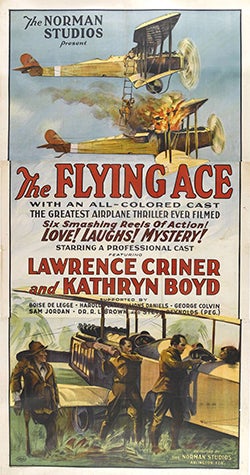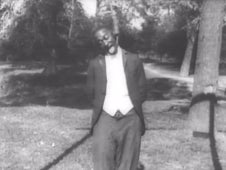I travelled to Bloomington, Indiana two weeks ago at the invitation of Brian Graney, formerly of UCLA Film & Television Archive, to attend the conference “Regeneration in Digital Contexts: Early Black Film” (November 15-16, 2013). Brian is now the archivist for the Black Film Center/Archive at Indiana University, which, according to their website, was founded in 1981 as an archive “dedicated to collecting, preserving, and making available historically and culturally significant films by and about black people. The BFC/A's primary objectives are to promote scholarship on black film and to serve as an open resource for scholars, researchers, students, and the general public; to encourage creative film activity by independent black filmmakers; and to undertake and support research on the history, impact, theory, and aesthetics of black film traditions.”

Long under the directorship of founder Phyllis R. Klotman, the Center’s Director is now Michael T. Martin, who attended our L.A. Rebellion symposium and is a contributor to our upcoming book. He is also the editor of Black Camera, which for twenty-eight years has been one of the only serial publications, dedicated specifically to black cinema.
Funded by a National Endowment for the Humanities grant, the symposium featured a select group of archivists and scholars working on so-called race films, all black cast films produced for mostly segregated audiences during the 1910s to 1940s. Given that the producers and distributors of such films operated at the very fringes of the mainstream industry, the loses are far greater than with American silent features, where only about 10% are known to survive. For example, only two of Oscar Micheaux’s twenty-one silent films are known to exist, and no race films survive from before 1920.
Remaining films are often fragmentary or damaged, so that film historians have had to rely on other forms of evidence, including film stills, posters, playbills, correspondence, scripts, distribution records, box office, newspapers, advertisements, reviews, contracts, censorship records, and even death certificates. After Shola Lynch’s moving keynote (she is the new curator of the Schomberg Center), scholars Matthew Bernstein, Dana White, Cara Caddoo, Terri Francis, Barbara Tepa Lupack and Charlene Regester discussed various innovative ways they have tracked race film distribution and exhibition in local communities in the South, utilizing just such ephemera.
 Another intellectual thread took its cue from Jacqueline Stewart’s dictum that “we can learn from the singularity of each print… and what it might teach us about the circulation, exhibition, and content of movies in this under-documented film culture.” (Film History, 2011) A panel of archivists, including my L.A. Rebellion co-curator, Jackie Stewart, myself, Mike Mashon, and Leah Kerr, discussed preservation issues relating to early black cinema, i.e. I reported on the many preservation problems we faced staging the L.A. Rebellion exhibition, emphasizing that they were similar to issues discussed with race films. After a closing roundtable that included many of the speakers, as well as Rhea L. Combs from the new National Museum of African American History and Culture at the Smithsonian, we screened Richard E. Norman’s The Flying Ace (1926), in a beautiful new print from the Library of Congress.
Another intellectual thread took its cue from Jacqueline Stewart’s dictum that “we can learn from the singularity of each print… and what it might teach us about the circulation, exhibition, and content of movies in this under-documented film culture.” (Film History, 2011) A panel of archivists, including my L.A. Rebellion co-curator, Jackie Stewart, myself, Mike Mashon, and Leah Kerr, discussed preservation issues relating to early black cinema, i.e. I reported on the many preservation problems we faced staging the L.A. Rebellion exhibition, emphasizing that they were similar to issues discussed with race films. After a closing roundtable that included many of the speakers, as well as Rhea L. Combs from the new National Museum of African American History and Culture at the Smithsonian, we screened Richard E. Norman’s The Flying Ace (1926), in a beautiful new print from the Library of Congress.
The second day’s workshop, on the other hand, was dedicated to making materials, whether films or ephemera, available in digital form. In particular, the question was how can we represent material objects digitally and what digital tools were potentially available to analyze and make accessible the surviving documents. The speakers, Brian Graney, Reto Kromer, Andy Ulrich, Will Cowan, John A. Walsh, and Doug Reside demonstrated a host of technical and conceptual solutions, which were surprisingly free of techno-geek formulations, allowing people like me to finally understand how certain aspects of digitality work. I was particularly interested in the new digital tools, e.g. Popcorn Maker, Cinemetrics, Digital Formalism, Omeka, Simile and Neatline, which allow the scholar to segment, dissect, analyze, and present film and ephemera documents.
 The official program ended with a matinee screening of Oscar Micheaux’s Within Our Gates (1920), which seems more amazing – despite the visible signs of damage – every time I see it, in particular the way Micheaux directly and consciously refutes the many, many lies propagated by D.W. Griffith’s The Birth of a Nation (1915). That film was followed in the evening by a screening of Billy Woodberry’s Bless Their Little Hearts (1984), and, on Sunday, Alile Sharon Larkin’s Your Child Comes Back to You (1979) and A Different Image (1982), all films representing the L.A. Rebellion. Larkin’s Child was in fact preserved at UCLA from original negatives housed at the Black Film Center, once again demonstrating that the project of film history and preservation, whether African-American or otherwise, will depend on interarchival cooperation and the input of film scholars.
The official program ended with a matinee screening of Oscar Micheaux’s Within Our Gates (1920), which seems more amazing – despite the visible signs of damage – every time I see it, in particular the way Micheaux directly and consciously refutes the many, many lies propagated by D.W. Griffith’s The Birth of a Nation (1915). That film was followed in the evening by a screening of Billy Woodberry’s Bless Their Little Hearts (1984), and, on Sunday, Alile Sharon Larkin’s Your Child Comes Back to You (1979) and A Different Image (1982), all films representing the L.A. Rebellion. Larkin’s Child was in fact preserved at UCLA from original negatives housed at the Black Film Center, once again demonstrating that the project of film history and preservation, whether African-American or otherwise, will depend on interarchival cooperation and the input of film scholars.






 Mobile Navigation
Mobile Navigation

